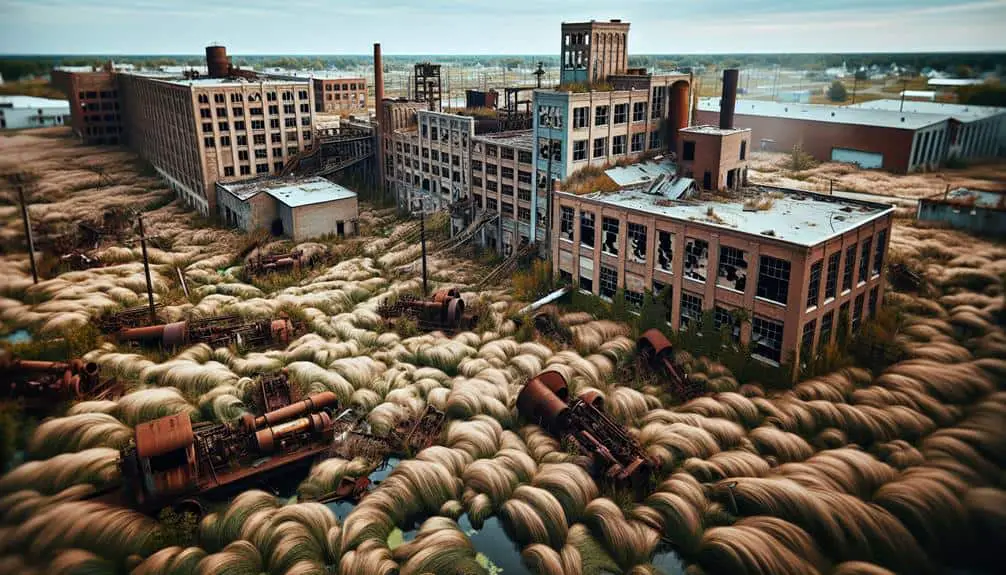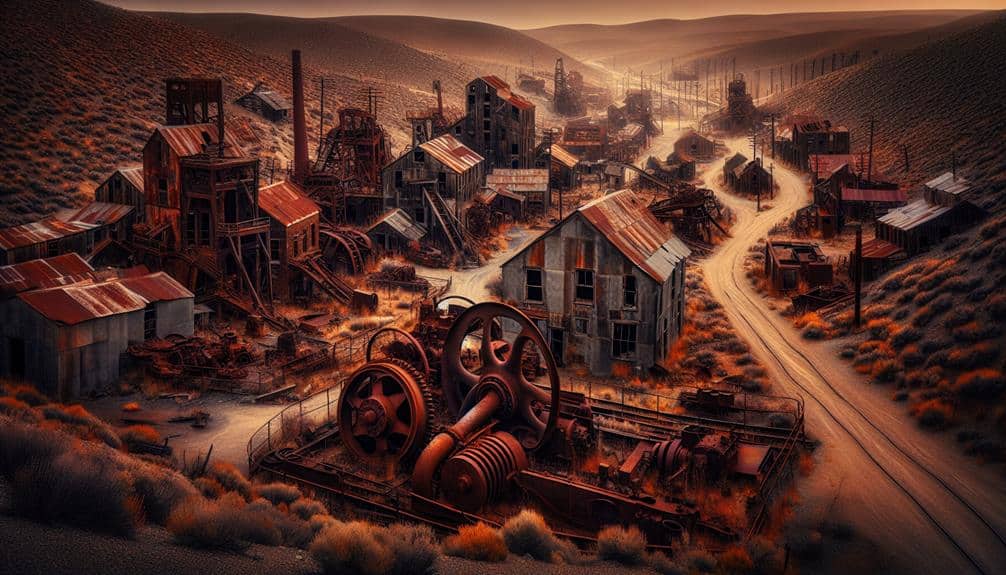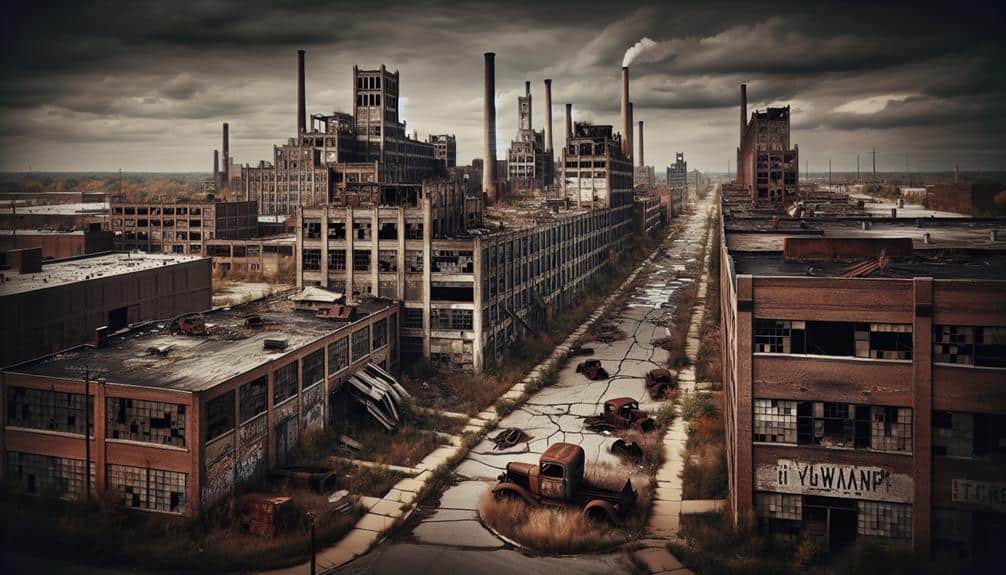Midwest factory towns become neglected due to economic shifts causing job losses, reduced tax revenues, and industry dependence. Corporate decisions like outsourcing and automation worsen the situation by impacting prosperity. Socially, residents face economic instability, mental health challenges, and lack of community support. Essential revitalization efforts are imperative, focusing on economic development, community engagement, infrastructure investments, and data-driven decisions. Understanding these factors is key to addressing neglect in factory towns. For deeper insights into historical background, corporate influence, social challenges, and revitalization strategies, explore further.
Key Points
- Economic shifts lead to job losses, impacting town prosperity.
- Outsourcing and automation reduce demand for human labor.
- Decreased tax revenues challenge community resilience.
- Corporate decisions affect revenue for essential services.
- Lack of economic diversification strategies hinders town adaptation.
Historical Background of Midwest Factory Towns
In the late 19th century, the Midwest factory towns emerged as bustling hubs of industrial activity, driven by the demand for manufactured goods and the availability of natural resources. The industrial revolution played a pivotal role in transforming these areas into centers of production, attracting a significant wave of urban migration as individuals sought employment opportunities in the growing manufacturing sector.
During this period, the Midwest became a key player in the industrial landscape of the United States, contributing substantially to the nation's economic growth. The development of factory towns not only provided jobs for the expanding population but also spurred advancements in technology and infrastructure. As urban migration intensified, the demand for labor in these factory towns soared, leading to a rapid increase in population density and urbanization.
The industrial revolution brought about significant changes in the social and economic fabric of these Midwest factory towns, setting the stage for the subsequent shifts in community dynamics and socioeconomic structures.
Impact of Economic Shifts on Communities
Amidst economic shifts, communities in Midwest factory towns have faced profound transformations impacting their social and economic landscapes. The decline of traditional manufacturing industries has led to job losses, population outflows, and decreased tax revenues, challenging the resilience of these communities. As factories close or downsize due to globalization and automation, the economic base of these towns weakens, creating a ripple effect on local businesses and services.
To combat these challenges, many communities are exploring economic diversification strategies to reduce their dependence on a single industry. By attracting new businesses, investing in education and workforce development, and promoting entrepreneurship, towns can adapt to changing economic realities and foster growth. Community resilience plays an important role in weathering economic shifts, as adaptable and proactive towns are better equipped to bounce back from adversity.
Role of Corporate Decisions in Decline
The economic decline in Midwest factory towns can often be traced back to significant corporate decisions that have shaped the trajectory of these communities. Corporate influence plays an important role in determining the prosperity or downfall of these towns. Here are some key points to ponder:
- Outsourcing: Decisions to outsource manufacturing operations to cheaper overseas locations have led to job losses and economic downturns in many Midwest factory towns.
- Automation: The implementation of automation technologies by corporations has reduced the demand for human labor, further exacerbating unemployment rates in these communities.
- Tax Avoidance: Some corporations engage in practices to minimize their tax obligations, depriving these towns of much-needed revenue for essential services and infrastructure development.
- Resource Exploitation: The exploitation of natural resources by corporations without adequate reinvestment in the local community can lead to environmental degradation and community disinvestment.
These factors underscore the significant impact of corporate decisions on the decline of Midwest factory towns, highlighting the need for a more balanced approach that takes into account the well-being of both corporations and the communities they operate in.
Social Challenges Faced by Residents
Social challenges faced by residents in Midwest factory towns manifest in various forms, impacting the fabric of these communities on multiple levels. The decline of manufacturing industries often leads to job loss, creating economic instability and increasing stress levels among residents. This can have a detrimental effect on mental health, with studies showing higher rates of depression and anxiety in areas facing economic downturns. Additionally, the lack of community support systems exacerbates these issues, leaving residents feeling isolated and without resources to cope with their struggles.
In such environments, social challenges can become deeply ingrained, affecting the overall well-being of the population. Without adequate mental health services and community support programs, residents may find it difficult to access the help they need. Addressing these challenges requires a holistic approach that involves not only economic revitalization but also prioritizing mental health resources and fostering a sense of community support. By recognizing and addressing these social challenges, neglected Midwest factory towns can work towards creating a more resilient and supportive environment for their residents.
Strategies for Revitalizing Neglected Towns
To revitalize neglected towns in the Midwest, implementing targeted economic development initiatives is essential for fostering sustainable growth and community resilience. Community engagement plays a pivotal role in understanding the needs and aspirations of residents, ensuring that revitalization efforts align with the town's values and goals.
Infrastructure investments are fundamental for improving the town's physical environment, attracting businesses, and creating job opportunities for the local population. Data-driven decision-making is key to identifying the most effective strategies for revitalization, optimizing resource allocation, and measuring the impact of initiatives over time.
Leveraging public-private partnerships can bring additional resources and expertise to the table, enhancing the town's capacity for sustainable growth and resilience. By combining these strategies with a commitment to transparency and inclusivity, neglected towns in the Midwest can set on a path towards revitalization, fostering a vibrant community where residents thrive and opportunities abound.
Frequently Asked Questions
What Are the Environmental Impacts of Neglect in Midwest Factory Towns?
When neglect lingers in Midwest factory towns, pollution impacts escalate, affecting community health. The environment deteriorates as resources dwindle, exacerbating health risks. Awareness and action are imperative to mitigate these detrimental effects.
How Have Changes in Technology Affected the Decline of These Towns?
Changes in technology, specifically the impact of automation, have led to economic displacement in Midwest factory towns. As machines replace human labor, jobs diminish, leading to a decline in these communities and neglect of their infrastructure.
What Role Does Government Policy Play in the Neglect of Midwest Factory Towns?
When it comes to the neglect of Midwest factory towns, government policy plays an important role. Government intervention in economic development can either revitalize or further neglect these communities, shaping their fate for better or worse.
How Do Educational Opportunities in Neglected Towns Compare to Other Regions?
In neglected towns, educational disparities hinder workforce development. Access to quality education and training lags behind other regions, impacting job opportunities. Addressing these challenges can revitalize communities and empower residents for economic growth.
Are There Any Success Stories of Revitalization in Midwest Factory Towns That Could Serve as a Model for Others?
You'll find inspiration in Midwest factory towns where community engagement and grassroots initiatives fueled economic diversification and job creation. These success stories offer a blueprint for revitalizing neglected areas with resilience and ingenuity.



